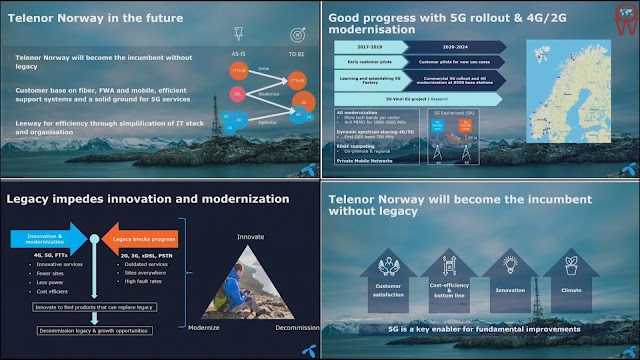In the recently concluded 5G World Summit 2021, Ingeborg Øfsthus, CTO of Telenor Norway provided a Holographic Service Provider Keynote on "Innovate, modernize and decommission, - moving Norway from legacy technology to high speed broadband with 5G, FWA and fiber"
Her talk was full of interesting facts about Norway and Norwegians. As a matter of comparison, UK for example is 3/4th the size of Norway while the population is roughly 12 times. This does not mean that the people out there expect anything less than the best from their operators.
Ingeborg Øfsthus (CTO at @TelenorGroup) said "The decommissioning of the old legacy is really good for the environment" and had the numbers to demonstrate in this morning's keynote at #5GWorld in London #5G #FWA #fiber pic.twitter.com/9msrJiajQL
— 5G World Series (@5GWorldSeries) September 23, 2021
This is a reason that Telenor has embarked on a journey to modernize their network (fixed and mobile) and phase out the legacy. There is an ongoing program to get rid of the copper network that has served the country well for over 160 years.
Users in urban and sub-urban areas can get fiber to their premises, be it home or business. The mobile network is being upgraded to 5G with 3G being shut down end of 2021. A small chunk of 2G will remain for fallback, roaming and IoT purpose. This whole modernization should be completed by 2024.
While Fiber will be available for most of the users, some rural and hard to reach areas may have to rely on Fixed Wireless Access. To ensure that good speeds are available to FWA as well as mobile users, granular planning is done to decide what kind of internet service would be offered in each area. In case of some very remote locations, Satellite broadband is provided as well.
As can be see in the picture above, Telenor has managed to stretch the C-band FWA as far as 3.6 kilometers. This of course requires line of sight outdoor antennas that have to be planned and installed by professional RF engineers.
Telenor considers all of these equipment to be part of the network so as to ensure a fantastic quality of experience to the end users. FWA is treated as fiber through the air by the end users.
As the old copper network is decommissioned, it is allowing a lot of power to be saved and indoor space to be reclaimed. Some of these old infrastructure is also a threat to wildlife as it's old and can fall down.
The main challenge is also to retain the customers while doing this transition from legacy to modern infrastructure. Telenor aims to retain at least 60% of the existing customers and 70% of the revenue. The approach using fiber and FWA is profitable and the best approach going forward.
Related Posts:
- 3G4G: Fixed Wireless Access (FWA)
- Telecoms Infrastructure Blog: Telia Norway Launches 5G Fixed-Wireless Access (FWA)
- Operator Watch Blog: Ice - bringing 5G to Norway
- The 3G4G Blog: The Journey from Communications Service Provider (CSP) to Digital Service Provider (DSP)
- Connectivity Technology Blog: Fixed Wireless Access (FWA) and the Path to 5G Wireless Wireline Convergence (WWC)
- Connectivity Technology Blog: Fixed Wireless Acess (FWA): A fantastic alternative to home broadband
- The 3G4G Blog: Introduction to Fixed Wireless Access (FWA)
- Operator Watch Blog - Orange Romania: 1st European 5G multi-vendor Fixed Wireless Access (FWA) test






